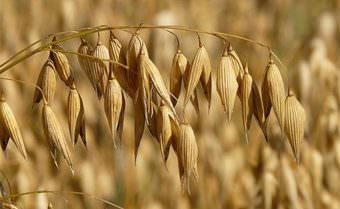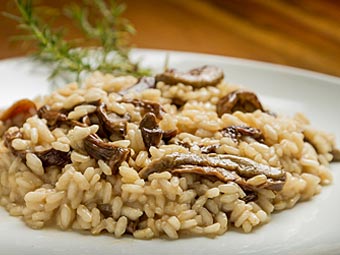
Risotto, a rice porridge – found in many varieties throughout Italy – albeit historically a dish of northern Italy. Depending on the recipe, white wine, seafood, mushrooms, meat, vegetables and parmesan are added. Rice is one of the seven most important cereals and forms the basis of nutrition for most of the world’s population.
Rice was already 400 BC. Cultivated in Mesopotamia, probably the rice came from ancient Persia. There, local farmers bred indica strains that are still relevant today in what is now Gilan Province. The Romans initially knew rice as a medicinal plant. It was also cultivated in Babylonia and Syria in Roman times. It was introduced to Spain by the Moors in the 10th century.
Incidentally, rice has been known in Italy since the Renaissance, mentioned in a document by the Duke of Milan in 1475 and grown mainly in the Po Valley. The best-known varieties suitable for risotto are Arborio, Vialone and Carnaroli.
Table of contents:
- Risotto basic recipe
- Rice types: suitable for risotto
- Rice types: unsuitable for risotto
- Recipe: Rolf’s Parmesan Lemon Risotto
- Recipe: Pumpkin Risotto
- Recipe: vegetarian vegetable risotto
- Recipe: Porcini Mushroom Risotto
- Recipe: Seafood Risotto
- Recipe: Oat Risotto
- Risotto from a cultural-historical point of view
- Prepare Risotto properly in German
- Now it's your turn, your support is needed
Risotto basic recipe
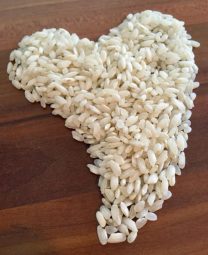 To do this, chopped onions are sautéed in good olive oil until translucent, a cup (about 250 ml, for 4 people) of rice (preferably Arborio or Carnaroli) is added and lightly sweated. Now it is deglazed with hot poultry or vegetable broth, also with white wine. During the cooking time, at a low temperature, hot vegetable broth or hot white wine (approx. 450 ml in total) must be added again and again and stirred well – do not let anything “bake”.
To do this, chopped onions are sautéed in good olive oil until translucent, a cup (about 250 ml, for 4 people) of rice (preferably Arborio or Carnaroli) is added and lightly sweated. Now it is deglazed with hot poultry or vegetable broth, also with white wine. During the cooking time, at a low temperature, hot vegetable broth or hot white wine (approx. 450 ml in total) must be added again and again and stirred well – do not let anything “bake”.
This procedure usually takes about 18 minutes – stir the risotto more often and add more liquid with a ladle if necessary. Depending on the recipe, the finished risotto should be creamy on the outside and al dente on the inside. Finally, 80 g good butter and 80 g grated Parmesan are added and folded in.
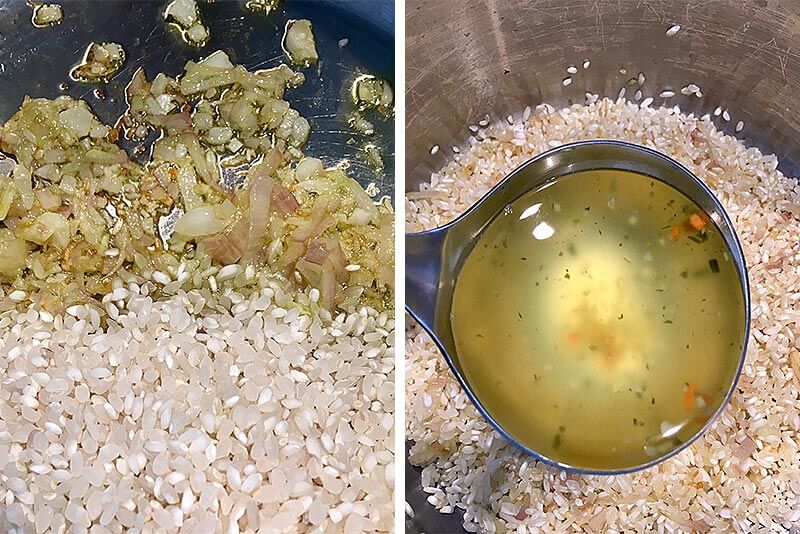
Rice types: suitable for risotto
The most important types of rice include Arborio (also Avorio) and Vialone Nano. Another, slightly less important variety is Carnaroli.
Arborio: (also Avorio) is mainly cultivated in the Po Valley of Italy. It is characterized by an oval, stocky grain. Among the Italian rice varieties, Arborio is the one with the largest grains. Arborio has a particularly high starch content. Thanks to these properties, the cooking liquid is bound and the grains remain al dente.
Vialone: The cultivation area is also northern Italy’s Po Valley. Today, the Vialone Nano variety is the main variety grown. This type of risotto has a distinctive crema and is difficult to overcook at the same time, as it remains al dente. So ideal for “risotto tryers”. The round-grained Vialone combines well with the ingredients.
Carnaroli: used to prepare creamy risottos that should remain “al dente”. This is achieved through its amylose content and cooking strength. This cook strength results from a relationship between slow migration of starch and water absorbency during cooking. Due to its lower yield per hectare, the Carnaroli is usually a little more expensive than the Arborio or Vialone.
Rice types: unsuitable for risotto
Broken rice, for example, which is also sold as rice pudding, is not suitable because it does not get the desired consistency during preparation.
Long grain rice is also unsuitable, as it releases too little of the starch responsible for the consistency when cooked al dente.
Recipe: Rolf’s Parmesan Lemon Risotto
You should have the following for 4 people in the house:
1 cup (approx. 250 ml) good risotto rice
450 ml vegetable broth or white wine
1 onion
1 organic lemon
butter
parmesan
salt
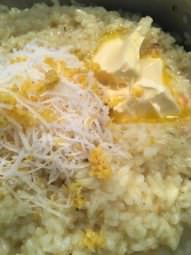 Just follow the basic recipe above: However, I only use good white wine (approx. 450 ml) as liquid, in which I dissolve 2 teaspoons of organic vegetable broth (instantly) and heat it up. This is important because adding cold liquid would stop the cooking process each time.
Just follow the basic recipe above: However, I only use good white wine (approx. 450 ml) as liquid, in which I dissolve 2 teaspoons of organic vegetable broth (instantly) and heat it up. This is important because adding cold liquid would stop the cooking process each time.
Stir well in between and gradually add the hot liquid. The risotto should now be ready after about 18 minutes. Now add approx. 80 g good butter and 80 g grated Parmesan – last but not least some grated organic lemon zest, which gives the risotto a fresh pep – mix everything well, serve and enjoy with a cool glass of white wine. Bon Appetit.
In short – in a good 30 minutes you have made a delicious risotto yourself.
Recipe: Pumpkin Risotto
 You should have the following at home:
You should have the following at home:
500 g fresh pumpkin flesh (preferably Hokkaido pumpkin)
1 onion
60 g butter 400 g Arborio rice
250 ml good, dry white wine
1 teaspoon organic vegetable stock (instant)
sea-salt
pepper
4 tablespoons Parmesan
2 tablespoons coarsely chopped pumpkin seeds (toasted)
It is prepared as follows: dice the pumpkin flesh and onion, sauté in half the butter. Add rice and deglaze with white wine. Let the white wine boil away and gradually add the hot wine and vegetable stock until the risotto is cooked. Now season with sea salt and pepper and leave to stand for a few minutes. Fold in the remaining butter and 4 tablespoons Parmesan. Sprinkle with toasted pumpkin seeds and serve.
Recipe: vegetarian vegetable risotto
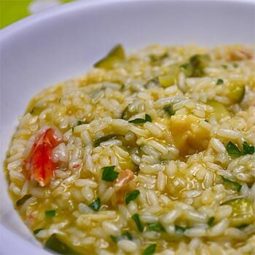 You should have the following at home:
You should have the following at home:
1 onion
1 fresh garlic clove
1 red pepper
1 green pepper
8 tablespoons olive oil
200 g Carnaroli rice
Salt
paprika
sweet
1 pinch of sugar
750 milliliters of water
250 grams of peas
215g carrots
150 grams of mushrooms
250 grams of tomatoes
40g grated Parmesan
It is prepared as follows: Let the diced onions, garlic and peppers become translucent in 10 minutes. Sprinkle in the dried Carnaroli rice. Fry while stirring. Season with salt, paprika and sugar. Gradually add the hot water. Simmer the Carnaroli rice over low heat for 18 minutes. Cut the carrots and mushrooms and add to the risotto with the peas. Boil the tomatoes, skin them, cut out the stalks and dice them and add them to the risotto. Salt and pepper – stir in the grated parmesan at the end. Complete.
Recipe: Porcini Mushroom Risotto
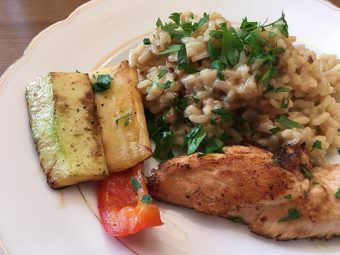 You should have the following at home:
You should have the following at home:
35 g dried porcini mushrooms
half an onion
90 grams of butter
320 g Arborio rice
Salt
pepper
250 ml good, dry white wine
70g freshly grated Parmesan
some chives
It is prepared as follows: Rinse the dried porcini briefly under water, then pour half a liter of hot water over them and let them soak for 30 minutes. Now remove the porcini mushrooms from the water, drain briefly on kitchen paper and cut into fine strips. Pour the mushroom water through a coffee or tea filter bag and set aside. Finely dice the onions, then sauté in 30 g butter until translucent. Add the strips of porcini mushrooms and sauté for about 1 minute. Add the rice and sauté briefly.
Pour in the white wine and let it simmer over medium heat, stirring often. Now add just enough mushroom water (hot) to just cover the rice, let it boil down again while stirring and so on, until the rice is cooked after about 18 minutes. When the rice is cooked, but still has a little bite (al dente), add the remaining butter and 50 g Parmesan to the rice and stir. Season with salt and pepper. Arrange and serve sprinkled with chives and the remaining parmesan.
Recipe: Seafood Risotto
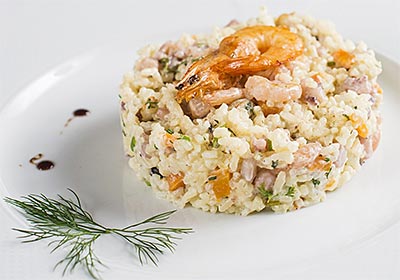 You should have the following at home:
You should have the following at home:
1 onion
1 clove of garlic
300 g Arborio rice
500 ml vegetable broth
100 ml good white wine
500 g seafood (frozen or fresh)
50g grated Parmesan
25 grams of butter
good olive oil
lemon juice
pepper
Parsely
marjoram
fresh dill
Prepare as follows: Peel and finely chop the onion and garlic. Sauté the onion in good olive oil, add the rice and sauté as well. Deglaze with some vegetable broth and set the stove to medium-high. When the vegetable broth has evaporated, add half of the wine, then gradually add the rest of the vegetable broth and the rest of the wine. When the rice is almost done, stir in the parmesan and about 25 g of butter, to taste. Add the garlic, seafood, chopped parsley and a little lemon juice and mix well. Season with marjoram, pepper and salt and leave covered for about 10 minutes. Serve and garnish with fresh dill.
Recipe: Oat Risotto
If you don’t feel like eating rice, you should definitely try a risotto made from oat kernels.
350 g oat kernels (rinsed with cold water)
1 bay leaf
450 ml cold water
1 bunch of green asparagus
1 tbsp olive oil
1 onion
1 teaspoon vegetable broth (instant)
1 tbsp margarine or butter
1 tbsp mascarpone
1 bunch of parsley
150 g cooked shrimp
It is prepared as follows: First of all, soak the oat kernels with bay leaves and water for about 8 hours. Finely chop the onion and sauté in olive oil. Add the oat kernels and bay leaves without the soaking water (please do not discard), steam briefly. Add the asparagus (sliced), soaking water and vegetable stock, cook for 3 minutes on a low heat, then remove from the heat and leave to stand, covered, for 12 minutes. Remove laurel. Now refine the whole thing with butter and mascarpone, pepper and salt. Mix in the prawns and serve.
Risotto from a cultural-historical point of view
Risotto is a traditional Italian dish made with arborio or carnaroli rice cooked in a broth and often flavored with various ingredients such as vegetables, meat, fish or cheese. In terms of cultural history, risotto has a fascinating history that stretches back to ancient times.
The origins of risotto can be traced back to ancient Persia, where a similar preparation called “pilaf” was practiced. Rice was cooked in broth to make a nutritious and storable dish. Over time, this method made its way to Spain and from there to the Mediterranean.
During the Middle Ages, rice was introduced to northern Italy, particularly to the Po Valley. The region’s humid climate and abundant water resources made it ideal for growing rice. The rice grains became perfect for making risotto because of their strength and texture.
Modern risotto is believed to have originated in northern Italy in the 14th century. It was at this time that the first recipes for a type of risotto called “risotto alla milanese” were published. This dish is made with saffron, which gives it its distinctive golden color. Legend has it that a painter named Valerius, who was responsible for decorating the windows of Milan Cathedral, mixed saffron into rice to make the color yellow more intense.
Over the centuries, risotto has been further developed in different regions of Italy, using local ingredients and culinary influences. Each region developed its own variations of risotto based on available resources and people’s preferences. For example, “risotto alla marinara” on the coast and “risotto alla zucca” in Lombardy with pumpkin were born.
Risotto has become an important part of Italian cuisine over time, representing the diversity of regional cooking traditions. It is not only a tasty dish, but also a cultural symbol of the connection between man, agriculture and history.
Today, risotto is enjoyed all over the world and has spawned many modern variations that transcend traditional recipes. Nonetheless, risotto remains an integral part of Italian culture and reflects the long history and diversity of culinary development in Italy.
Prepare Risotto properly in German
You can find this article in German at www.rolfkocht.de as “Risotto selber machen: Grundrezept und einfache Rezepte”
Now it's your turn, your support is needed.
Did you like the post "The easy risotto recipe you’ll ever need – basic recipe and many different risotto recipes"?
Simply select the number of stars and click. Thank you very much for your review ![]()

